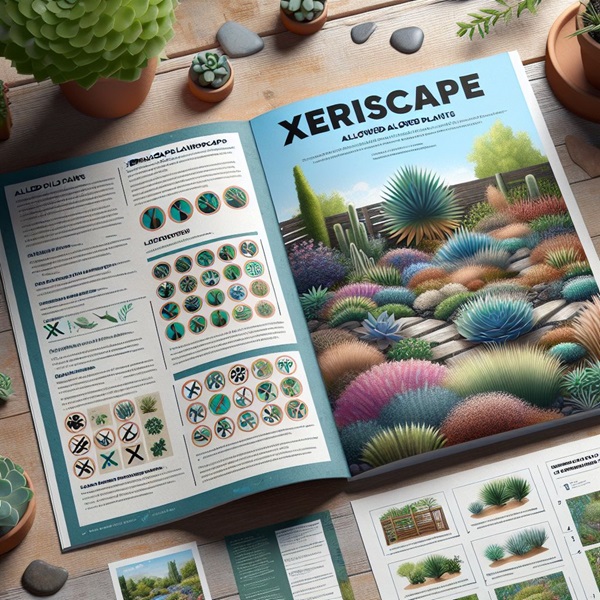
Key Takeaways
- Xeriscaping is a landscaping approach that conserves water and is encouraged in South Dakota.
- Understanding your HOA’s regulations is crucial before starting a xeriscape project.
- Selecting the right plants is key to a successful xeriscape in South Dakota’s climate.
- Communication with your HOA can lead to a xeriscape that is both beautiful and compliant.
- Native plants and drought-tolerant species are ideal for South Dakota
.
Greener Gardens, Less Water: Why Xeriscaping Makes Sense in South Dakota
Imagine stepping outside to a garden that thrives in South Dakota’s climate, bursts with color, and yet, barely whispers for a drink. That’s the beauty of xeriscaping. It’s a practical and stunning way to garden that meshes perfectly with our local weather patterns, which can be unpredictable and often dry. This method of landscaping not only conserves precious water resources but also creates a harmonious outdoor space that resonates with the natural beauty of our region.
Conserving Water in a Garden Landscape
Water is a valuable commodity, and in South Dakota, we know all too well that every drop counts. Xeriscaping is a proactive approach to garden design that significantly reduces the need for water. It’s not just about drought-resistant plants; it’s about creating an entire ecosystem that works with our local environment, not against it. By incorporating xeriscaping into your garden, you’re not only conserving water but also investing in a landscape that can withstand South Dakota’s weather extremes.
The Beauty of Drought-Tolerant Flora
Drought-tolerant plants are the stars of a xeriscape. They’re the resilient, low-maintenance heroes that save you time, money, and water. But don’t mistake drought tolerance for dullness; these plants come in a variety of shapes, sizes, and colors. When you choose the right plants for our climate, you’ll be rewarded with a garden that’s both vibrant and sustainable.
Know Your HOA’s Green Rules: South Dakota Xeriscaping Policies
Before you grab your shovel and start transforming your yard, there’s an important step you must not skip: checking in with your Homeowners Association (HOA). In South Dakota, many HOAs have embraced the concept of xeriscaping, understanding its benefits for sustainability and property values. However, they may have specific guidelines you need to follow to ensure that your xeriscape is not only eco-friendly but also community-friendly. For more detailed information, consider reviewing Living Landscapes in South Dakota: A Guide to Native Plantscaping.
Decoding Landscape Restrictions
Each HOA has its own set of rules, and it’s essential to understand them fully. Some might have restrictions on the types of plants you can use or require certain design elements to maintain a cohesive look within the community. By familiarizing yourself with these regulations, you can create a xeriscape that fits within the rules and still expresses your personal style.
Aligning Your Xeriscape With Community Aesthetics
Most importantly, your xeriscape should enhance the community’s aesthetic. This means selecting plants and design elements that complement the existing landscape. South Dakota’s natural beauty offers a rich palette to draw from, and by choosing native plants, you can create a xeriscape that looks like it belongs.

The Heart of Xeriscaping: Choosing the Right Plants for South Dakota
Because the cornerstone of any successful xeriscape is the plant selection, let’s focus on the vegetation that will make your garden both resilient and remarkable. South Dakota’s climate demands plants that can endure hot summers and cold winters, and xeriscaping is all about choosing species that naturally thrive under these conditions. Therefore, it’s essential to pick plants that are well-adapted to our local environment to ensure a flourishing, low-water landscape.
Example Xeriscape Plants
| Plant | Description | Estimated Cost |
|---|---|---|
| Sedum | Drought-tolerant succulent plant | $5-$10 per plant |
| Ornamental Grasses | Low-water, low-maintenance grasses | $10-$20 per plant |
| Echinacea (Coneflower) | Native, drought-resistant perennial | $5-$15 per plant |
| Rudbeckia (Black-Eyed Susan) | Native, heat and drought-tolerant flower | $5-$10 per plant |
| Gaillardia (Blanket Flower) | Drought-resistant, long-blooming perennial | $5-$12 per plant |
References:
https://www.southdakotamagazine.com/high-mountain-gardening
https://eu.aberdeennews.com/story/lifestyle/2018/06/24/gardening-made-simple-xeriscaping-what-is-it-and-why-do-i/44430047/
https://www.slideshare.net/Simm846q/m4s137
https://xeriscapeswan.com/xeriscaping-friendly-states-grants-rebates-legal-guide/
Drought-Tolerant Stars: Spotlight on Native Species
Native species are the unsung heroes of the xeriscape garden. They’re already perfectly adapted to South Dakota’s climate, which means they require less water and maintenance. Incorporating native plants such as the Pasque Flower, the state flower of South Dakota, or the Leadplant, with its silvery foliage and spiky purple blooms, can provide your garden with a sense of place and a connection to the local landscape.
DIY Xeriscaping: Crafting a Water-Savvy Garden that HOAs Love
Creating a xeriscape that is both beautiful and compliant with your HOA’s guidelines is a rewarding DIY project. Start with a clear plan that includes drought-resistant plants and appealing design elements. A well-thought-out xeriscape can enhance your property’s curb appeal and can even become a model for sustainable landscaping within your community.
Blueprinting Your Xeriscape Plan
Begin with a blueprint of your existing yard, noting areas of sun and shade, existing vegetation, and any slopes or drainage patterns. This will help you determine the best locations for plants and hardscape elements. When designing your xeriscape, consider grouping plants with similar water needs together to create “hydrozones.” This will make your garden not only more water-efficient but also easier to maintain.
From Approval to Applause: Navigating HOA Feedback
Once you have your xeriscape plan, it’s time to get approval from your HOA. Present your plan with detailed information about the plants and materials you intend to use. Be prepared to explain how your xeriscape will enhance the community and comply with the guidelines. With a well-designed plan and open communication, you can turn potential skepticism into enthusiasm and support for your water-wise garden.
Paving the Path: Gravel, Rocks, and Other Xeriscape Foundations
In addition to plants, xeriscaping often incorporates inorganic materials like gravel, rocks, and pavers. These elements play a crucial role in reducing water use by covering areas where grass might otherwise be planted. They also add texture and contrast to your xeriscape, creating a visually striking and low-maintenance landscape.
Understanding the Role of Inorganic Elements
Inorganic materials are more than just decorative; they help to retain moisture in the soil, reduce weed growth, and provide erosion control. Gravel and rocks can also create natural pathways and define different areas of your garden, making it more functional and accessible.
Designing with Durability and Drainage in Mind
When incorporating inorganic elements into your xeriscape, it’s essential to consider durability and drainage. Choose materials that can withstand South Dakota’s temperature fluctuations and that won’t break down easily. Properly installing these elements with an eye toward drainage will ensure that water is directed to your plants when needed and not wasted.

FAQ: Homeowner Associations and Xeriscaping in South Dakota
Can My HOA Ban My Xeriscape Garden?
It’s a question many eco-conscious homeowners ask, and the answer is reassuring. South Dakota law supports xeriscaping, meaning HOAs cannot completely ban the practice. However, they can establish guidelines to ensure xeriscapes are in harmony with the community’s overall aesthetic. So, while you have the right to xeriscape, you’ll need to do so within the framework your HOA provides.
It’s important to remember that an HOA’s goal is to maintain a certain standard for the appearance of the community. Therefore, when you’re planning your xeriscape, consider the existing neighborhood style and aim to create a design that complements it. By doing this, you’re more likely to gain the support of your HOA and your neighbors.
South Dakota’s supportive stance on xeriscaping stems from its environmental benefits, which include water conservation and reduced maintenance. By emphasizing these points, along with a thoughtful design that enhances the neighborhood, you can build a strong case for your xeriscape garden.
- Review your HOA’s landscaping guidelines carefully.
- Design your xeriscape to align with community aesthetics.
- Emphasize the environmental benefits of xeriscaping.
- Communicate openly with your HOA about your plans.
- Be prepared to compromise and make adjustments if necessary.
How to Propose Xeriscape Changes to an HOA
When you’re ready to propose your xeriscape garden to your HOA, preparation is key. Start by putting together a comprehensive plan that includes detailed drawings, a list of plants and materials, and an explanation of the benefits of xeriscaping. Make sure your proposal addresses any potential concerns the HOA might have, such as maintenance or design cohesion. For more insights on aligning with HOA regulations, consider reading this guide on eco-friendly landscaping tips that comply with HOA rules.
Next, reach out to your HOA board to find out the process for submitting your proposal. Some associations may require you to present your plan at a meeting, while others might have a formal application process. Understanding these procedures will help you navigate the process smoothly.
Once you’ve submitted your proposal, be open to feedback. The HOA may request changes or provide suggestions to help your xeriscape fit better with the neighborhood. Remember, the goal is to create a garden that you love and that also meets the standards of the community.
What are Typical Xeriscape Maintenance Requirements?
One of the joys of xeriscaping is the reduced maintenance compared to traditional landscaping. Once established, xeriscape gardens typically require less watering, fertilizing, and mowing. However, they’re not maintenance-free. You’ll still need to engage in weeding, occasional watering during extreme drought, and pruning to keep your plants healthy and the garden looking tidy.
Regular maintenance also involves monitoring the health of your plants and the soil. Over time, you may need to replenish mulch, divide perennials, or replace plants that aren’t thriving. By staying on top of these tasks, your xeriscape will continue to be a sustainable and beautiful part of your home.
Do Xeriscape Practices Affect Property Values?
A well-designed xeriscape can positively impact property values. These landscapes are attractive to potential buyers who are looking for homes with sustainable, low-maintenance gardens. A xeriscape that is lush, colorful, and well-maintained can be a selling point, demonstrating that eco-friendly living can also be luxurious.
Moreover, as water conservation becomes increasingly important, properties that already feature water-wise landscaping may become more desirable. If you’re considering xeriscaping, view it as an investment in your property’s future value as well as the environment.
- Xeriscapes can increase curb appeal and property value.
- Water-wise landscaping is becoming more desirable to homebuyers.
- Maintaining your xeriscape ensures its continued appeal and functionality.
Remember, the success of a xeriscape in boosting property value lies in its design and upkeep. A neglected or poorly designed xeriscape could have the opposite effect, so it’s crucial to commit to the ongoing care of your garden.




Leave a Reply